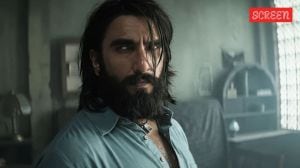Click here to follow Screen Digital on YouTube and stay updated with the latest from the world of cinema.
Leonardo DiCaprio on Django Unchained’s painful ‘right n***er’ scene where he cut himself: ‘Did it bloodied…’
As Quentin Tarantino directorial Django Unchained turns 10, we revisit the time Leonardo DiCaprio had got candid about cutting his hand open while filming its climax.
 A still of Leonardo DiCaprio from Django Unchained.
A still of Leonardo DiCaprio from Django Unchained. Filmmaker Quentin Tarantino‘s movies, though admired, are often mired in controversies. With regard to his 2012 release Django Unchained, the Oscar-nominated director faced a lot of flak for his ‘overuse’ of the racial slur n***er (more than 100 times reportedly), and the fact that Tarantino, a Caucasian himself, was helming a project about slavery. He was called out for indulging in what was perceived by a section of audience to be ‘White man’s saviour complex’ in which a white person is given the responsibility to do all the heavy-lifting and ‘saving the souls’ drill. Tarantino has rubbished those allegations, and Django star Jamie Foxx has lauded the director for getting a movie about slavery greenlit in the first place.
Despite its issues and its traumatic topic, Django Unchained is an engaging, (and often darkly comedic) piece of art that is filled with great performances and an even better soundtrack. Do you recall that bit when Leonardo DiCaprio (who, by the way, had never played a supporting part as an adult actor before this) cut his hand open while banging the table as he addressed Christoph Waltz and Foxx’s characters? Tarantino is notorious for the amount of gore and violence that goes into making his films, but this one time he had not asked the special effects team to do their usual magic.
DiCaprio had actually hurt himself while doing the act, and if you have seen the film, you will have an idea about the amount of blood he lost as he continued with his take. Later, during an interview, Leonardo said that the whole noise had made even Tarantino look up from camera to shoot a quizzical look at his star: “My hand started really pouring blood all over the table. Maybe they thought it was done with special effects. I wanted to keep going. It was more interesting to watch Quentin’s (Tarantino) and Jamie’s (Foxx) reaction off-camera than to look at my hand. We did it bloodied and bandaged for the rest of the movie. I’m glad Quentin kept it in,” the actor told The Hollywood Reporter. As soon as Leonardo was done, the crew erupted in applause.
The scene in question was, all the real bloodshed notwithstanding, quite painful for everyone involved. Kerry Washington, who played the slave Broomhilda, had told THR she was in a constant state of panic, adding, “It was the film that never ended. I had nightmares about it: I was feeling trapped. I had no ability to make decisions about where I’m going and what I’m doing. I was concerned for my sanity.” For her scenes, Kerry was placed in a coffin-shaped metal box called a ‘hot box.’ In the Leonardo scene, the actor was dragged by the hair and verbally abused by his racist character Calvin.
Casting veteran artiste Samuel L Jackson, known to most Gen-Z and Marvel-loving youth as Nick Cage, in Django Unchained was another story. Jackson had his own apprehensions about being in the film, despite having worked with Tarantino before — “I told him, ‘I can’t be the hero, and now you want me to be the most hated N***o in cinematic history?’” The director of course laughed it off, saying Jackson had just stepped off the Broadway playing Martin Luther King before that.
Django Unchained, despite the polarising views, went on to become a box office hit, minting over 420 million dollars of its reported 100 million dollar budget.
Django Unchained is available to stream on Netflix, YouTube and Amazon Prime Video.
- 01
- 02
- 03
- 04
- 05


































